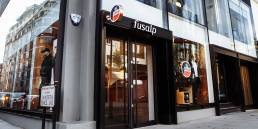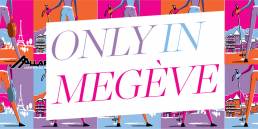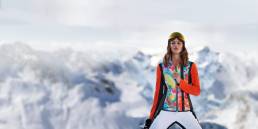It takes a lot of pressure to change rock — maybe more to change a culture.
Photography by Mattias Fredriksson
On an early January day, the fabled Gemsstock at Andermatt ski area feels all but deserted. It isn’t, of course, yet an unexpected two feet of fluffy new snow has yet to pack the peak’s two linked trams, which run half-full to the 9,717 foot glacier-rimmed summit. As I debark, only a handful of out-of-their-leaguers stare with eyebrows raised down the steep, off-camber piste toward the manicured embrace of lower chairlifts, while the ranks of giddy free-skiers normally scrambling 360-degrees off the Gemsstock are as thin as the air, many having uprooted to snowier environs during an uncharacteristically low-snow early season. I’m certainly not complaining about the peak’s now-abundant space
As I aim for the Felsental, a spectacular off-piste descent I’ve come to favor over a quarter century of visiting this oddball corner of the Swiss Alps, I’m trailed by those with similar ambition. One is a guide leading an older but clearly capable woman. His hardened face resembles the crust of the Earth itself — molten fire bubbling beneath flinty eyes, the creases at their corners a convolution of outdoor experiences laid down over the years. As I stop at the entrance, snow collapses around a hidden rock. The guide leans forward to tap it with his pole, a universal gesture of caution for his client. We flash each other knowing grins and disappear into our respective voids, certain it will be a long, wary — but rewarding — way down.
In an age of soft adventure, it’s hard to imagine such a gnarly concatenation as the alpine centerpiece for yet another mega-resort, but happily for adventuresome skiers such is the case. Stoic, long-resistant traditionalists, Andermatters are not only tolerating a sea change in the life of their village, but seem genuinely starry-eyed over the arrival of luxury hotels, moneyed clientele, and new lifts that link Andermatt to the once-moribund ski areas of Sedrun and Disentis, revitalizing all within a grand SkiArena Andermatt-Sedrun — a salvation coda after its main employer, the military, pulled up stakes in 1999, followed by the 2016 opening of a new train tunnel (world’s longest and a wonder in itself) that bypassed
the valley.
This part of the Alps has always been an important junction of east-west and north-south travel: German-speaking Switzerland continues to the north via the Schöllenen Gorge of the Reuss River, spanned by the infamous Devil’s Bridge; the next town south over the St. Gotthardpass is Airolo, in Italian Switzerland; to the west over the Furkapass lies French Switzerland; cross the Oberalppass to the east and you’re in the archaic Romansch part of the country, where no Berlitz dictionary can help you.
Archaeological traces of semi-nomadic visitors to this high valley at 4,747 feet date to 4000 BC, but the first settlements occurred a century after the Romans vacated the region, with the arrival of Alemannic Walser tribes around 500 AD. Though its first mention in writing as A der matt — “at the meadow” — in 1290 AD has more to do with once-abundant bears and wolves, the reference is bookended by descriptions of catastrophic avalanches that periodically razed the town; the last, in 1975, leading to a spate of tree-planting and other avalanche-prevention on surrounding slopes.
Andermatt ski resort also presents a realm of myth, legend and fantasy spun with Satan himself, Benedictine monks, a Russian army general, treasure-laden Irish earls, William Tell, Goethe, Elvis Presley, James Bond, and, most recently, Egyptian property developer Samih Sawiris, who opened the town’s transformation set-piece — the almost ethereal five-star Chedi hotel — in 2013. Clearly, it’s a town with tales to tell.
One long-running story is Metzgerei Muheim on the Gotthardstrasse, a family-run butcher-shop and fromagerie where those in the know grab the most honest sandwich in town to stuff in their packs en route to the Gemsstock. Founded in 1900 and now managed by third-generation Ferdinand Muheim and wife Esther, meat from a range of free-grazing livestock is dried in fresh mountain air and paired with a range of cheeses from around the Alps; a proprietary “Gottardo” fondue mix is blended by Ferdi himself. With the global food-and-beverage revolution’s focus on local sourcing, Ferdi also supplies many upscale enterprises, notably the Chedi and several new on-mountain restaurants. As a 17-year member of local government and mayor for eight, with 20 years on the board of the floundering, debt-heavy ski area, Ferdi doesn’t hesitate in his evaluation: “Samih saved Andermatt. He speaks German so we were friends right away. And he always calls when he’s in town,” enthuses Ferdi. “Zermatt and St. Moritz are done, so only Andermatt could expand in this way. We’re always busy now — even spring and fall.”
Despite the legion of comings-and-goings over the area’s history as a geographic and cultural crossroads, a high-end future is rapidly descending, raising the perennial question of whether the drive to get big or perish will leave powder-hounding guides and ski bums — who kept Andermatt ski resort afloat through the bad times — poor men in a rich man’s world, or beneficiaries of the renaissance.
Bānz Simmer pulls up outside Toutoune — a bright, open-concept Mediterranean bistro — on a fat bike, leaping off the way a thirsty cowboy might dismount outside a saloon and flying past the window to reappear at my elbow. Wild-eyed and stubbly under a newsboy cap, Bānz (pronounced Baines), I’ve been assured, knows more about Andermatt ski resort than most. These days, the old-school snowboarder who’d once cycled from Switzerland to China shepherds tourists on bike, foot
and snowshoe.
While I tuck into a Flammkuchen, a delicious flatbread adorned with various toppings and crème fraiche, Bānz dispenses historical tidbits between bites of what he claims as the best falafel in the Alps — beginning with the co-opting of these rocky redoubts as de facto defense.
Encircled by mountain ramparts, Andermatt’s Shangri-La vibe not only attracted vacationing royalty, celebrities and wealthy industrialists, but the Swiss Army high command, which, beginning in 1885, riddled the peaks and passes with fortifications and a labyrinthine underground warren. Eventually, thousands of soldiers were stationed here to defend against incursion from any direction. But what to do while waiting? Ski, of course. Thus, Andermatt became one of Switzerland’s first towns with a ski lift (1937), set at the foot of the Oberalp.
It was a good gig for soldiers, who skied and trained for mountain warfare, as well as the town’s largely old-school commerce, which became reliant on military financial largesse. Until the Cold War ended, that is, when the country’s taxpayers soured on the garrison’s $1 million/day price-tag. As the troops departed, the gentry looked to pick up economic slack through tourism. But isolation, low capacity and ageing infrastructure made it a tough go, leading to a funk of empty streets and uncrowded pistes. Meanwhile, the international ski-bum rumor mill had come to hold Andermatt ski resort in thrall as a reliably snowy place where one might bag 30,000 vertical feet of untracked snow in a good day off the Gemsstock, and this reputation as a freerider’s paradise had cemented by the mid-1990s when I first visited.
Snow and terrain were the draw then, but it was immediately apparent that Andermatt ski resort flaunted other charms — despite attempts by postmodern builders to cheapen its classic alpine architecture. Framed by rocky palisades, historic wood-beam inns and fish-scale-clad guesthouses line cobblestoned streets, the skyline defined by churches sporting byzantine onions and steep rooves lined with birds that grow little white hats during frequent snowfalls. A chapel built in 1740 features a ceiling mural in an arched portico; another contains elements from a string of structures on the same site used for worship since 900 AD; the down-valley town of Hospental, a frequent off-piste destination, coalesces around an 11th-century tower.
Sated on both food and information, we stroll to Bānz’s Internet-café office, ode to an earlier digital age before smartphones doomed such enterprises to new-millennial footnotes. Inside are ancient boxy laptops cabled to small tables, a forlornly dripping espresso machine, and rock-filled boxes that puff dust as I pass. Some 70 minerals are known from the local mountains where Bānz once conducted “crystal hikes,” but when this enjoyable natural history enterprise morphed into chaperoning New Agers seeking crystals for supposed mystical powers, Bānz was put in mind of the animistic and deeply superstitious tribes that once populated the valley, and he scrapped the excursions.
History isn’t always sorted into such distinct layers. One wall features a paean to Andermatt’s previous jet-set flirtation — a poster of a young, flap-eared Sean Connery as James Bond, leaning against the Aston Martin from the car-chase scene in Goldfinger, filmed here. As I leave, Bānz offers me some sun-faded postcards from a rusty rack — bygone souvenirs in an age of real-time Instagrams. One is an aerial view of Oberalp, linchpin in the SkiArena Andermatt-Sedrun concept, depicting the once-open alps that are now crisscrossed by lifts. The changes are a reminder that the past is what it is, while the future is what you make it. Like many, Bānz is banking on that.
It’s also a reminder of my ski plans, and when the next morning dawns sunny with more new snow I leave my comfortable nest in the stylish Radisson Blu Reussen, a modern-Swiss-meets-Scando-design property anchoring a plaza of new development on the north end of town, and hop a shuttle to the train station where I stroll underground to an escalator that lifts me directly to the recently inaugurated Nätschen-Gütsch express gondola.
Past the Nätschen mid-station at 6,043 feet the skiing is all above treeline. Despite numerous southern aspects, the snow and grooming are typically good and the views on a sunny day stunning — the reason even beginners will find the straightforward zig-zag of lifts and pistes now carrying you over the Oberalppass intoxicating. Though smallish by Swiss standards, Andermatt ski resort has always seemed vast. One reason is that you can ski off any aspect of the Gemsstock, each route leading to a different valley, something best appreciated in the sightlines from the Gütsch top station; another is the reverse view, from the Gemsstock to the expansive Oberalp, the frequent intrusion of a tiny, sinuous, red Matterhorn Gotthardbahn winding its way through the pass like a snowy model train diorama delivering required perspective. Now that it’s all one enormous ski domain, the feeling is only multiplied.
At Gütsch, you’re greeted by a stone building whose contemporary architecture blends perfectly with the mountainous backdrop that seems to stampede right into the room through its picture-window facades. Inside, two restaurants represent an entirely new approach to on-mountain dining: instead of yet more quotidian pizza, spaghetti and würst, they complement the town’s growing gourmet scene. The Japanese, spin-off of an eponymous Chedi restaurant, may seem improbable up here, but as manager Dietmar Sawyere notes: “Anyone who has wintered in Japan knows how well their cuisine suits mountains.” Its housemate, Gütsch by Markus Neff, is a creation of the renowned 2007 Swiss Chef of the Year who ran Saas Fe restaurants for decades; food is modern continental, incorporating both art and fun.
But today I have other lunch plans. And it takes me only two lifts, three wide-open powder runs, and all of 30 minutes to reach the Oberalppass, where I cradle a simple French fries and beer on the sun-soaked deck of Restaurant Piz Calmot. Mirroring the recent past, several dozen Swiss soldiers on a ski tour have stopped to dig bivouac caves. If I didn’t linger over my lager watching them shovel, I might have continued on to Disentis, hopping the specially outfitted après-ski train back to Andermatt ski resort — a rolling, music-pumping bar with appropriately graffitied exterior. But then, too much afternoon fête might have spoiled my dinner at Hotel Bären.
Only 100 yards from the Gemsstock tram and a symbol of Andermatt’s new optimism, family-run Bären occupies an old, multi-story house converted to modern boutique hotel. The restaurant’s refined Ticino cuisine has been a hit since opening in 2014, a place where I’ve enjoyed several out-of-this-world dinners. Tonight is no exception, from an amuse-bouche of spicy beef in puff pastry, to carpaccio exotique with a sublime mango/mint drizzle, to pork belly resembling a slice of cake on crunchy potatoes with sweet scallions and a disc of chopped-to-perfection Swiss chard. Most memorable is eggplant parmigiana — a melt-in-your-mouth rendition of a standard, the flavors swimming frantically around my mouth like trapped goldfish, flashing here, pausing there. All washed down with a white merlot (yes, white) from the family’s Ticino-based winery, its finish smooth enough to calm my mesmerized palate.
The days of Gotthardstrasse haute cuisine being a plate of spaghetti bolognaise scarfed in the company of loud men in camouflage are truly done.
There’s a buzz in the meadow these days — doubtless due to the sheer size and scope of its impressive makeover. For an investment of $2 billion, Andermatt is realizing six 4- to -5-star hotels, 42 apartment complexes with 500 units, 28 exclusive chalets, convention facilities, concert hall, public indoor pool, 18-hole championship golf course, modernization of the train station, and lift upgrades linking Andermatt and Sedrun. Over half complete, none of this has intruded on the historic charm of an original village that feels exactly as it did on my first turn 25 years ago.
Indeed, Andermatt remains disarmingly real, a place where you might glance down an alley and see someone pitch-forking hay or milking a cow, folks who’ve run inns for centuries for travelers who’ve crossed one pass or another into this crucible. It’s the kind of discovery place rarely found in the glitzy international ski scene it now joins—a key element recognized by Samih Sawiris when he began championing development in 2005. Gazing out over the town on the ski-out from Nätschen, unless you know where it is, the massive Chedi complex is indistinguishable from Andermatt’s centuries-older snow-limned rooves. Complementary architecture is one way of getting it right, and new houses in town are following suit, designing in the old shapes with wooden exteriors but modern technology and interior design; timelessness this may not be, but it’s certainly being honored.
Though I weigh another dinner at the Radisson Blu’s exceptional Restaurant Spun — and after having last enjoyed their hand-cut Swiss beef tartare, smoked almond crème, and a trilogy of sumptuous pork and green Ticino risotto with leek straw and fir oil, who wouldn’t? — I opt instead to step into the past at venerable Restaurant Ochsen, where the bubbling fondue, garnished in herbs, is divine. When I quiz the proprietor on the cheeses in his recipe, he smiles and gently shakes his head. “Local secret,” he says.
On the way home, I stop at the Chedi for a nightcap. With every encounter its opulence and innovation remain jaw-dropping. From the outsized 18 foot-high glass entry doors, to the entrance hallway ushering you toward a fireplace adorned in stylized moose-antlers, to a slate check-in desk — possibly the world’s longest — beneath thousands of dazzling lights hung from decorative tiles, to the one-of-a-kind cheese room (supplied by Ferdi Munheim), to the wine library and lounge where I insinuate myself, every inch screams brilliance. Even if you can’t afford to stay, you can’t afford not to drop in for a glass of wine.
Though it defines Andermatt’s metamorphosis, many were still surprised when the Chedi took wing. “I would never have predicted something like this,” says a gobsmacked Swedish tour operator who has been coming here for decades and seen every grand hotel in the Alps. “Nothing compares,” he adds. “It’s a seven-star.”
Of course, there’s no such thing—and that’s his point.




